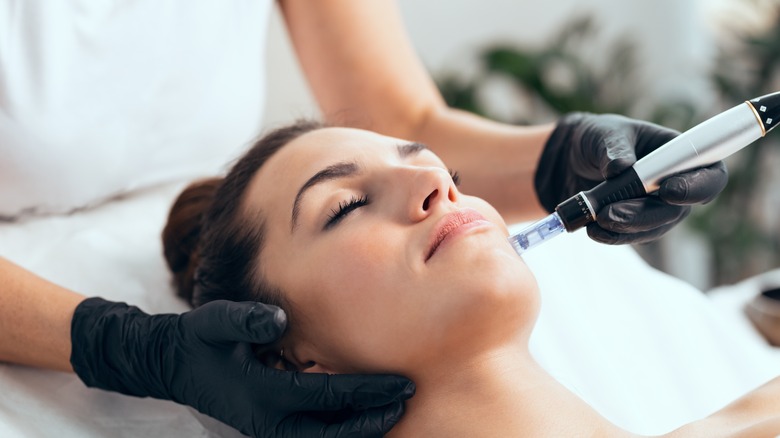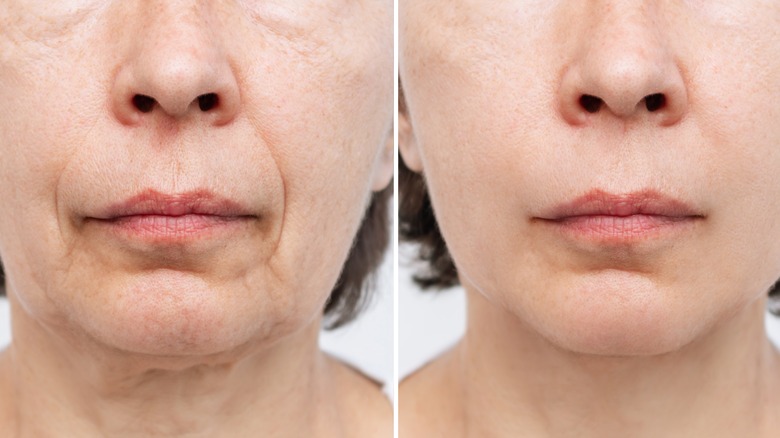Micro-Coring: What To Know About The Procedure That Promises Tighter Skin Without The Downtime
When it comes to anti-aging treatments, many professionally-administered procedures are available at a dermatologist or plastic surgeon's office. There are surgical facelifts for those who want to undo accumulated signs of aging. And there are minimally invasive methods such as Botox, thread lift, and micro-needling for those who need a temporary fix for their saggy skin and wrinkles. But what if minimally invasive treatments are not strong enough to give you desired results, but you're not ready to go under the knife just yet?
Fortunately, there are in-between procedures for those in that dilemma, too. Among them is micro-coring, a cosmetic treatment that promises to permanently give you tighter and firmer skin by eradicating micro-portions of excess skin. What's more, this tissue removal method doesn't involve any cuts or stitches. This definitely sounds like a dream come true for those who are too tired of injectable touch-ups or take exception to the risks that come with surgeries. The ellacor system, the first micro-coring technology on the market, was created by medical technology company Cytrellis and received FDA approval in 2021 for use on the mid and lower face. Below, check out everything you need to know about micro-coring, one of the most sought-after treatments for facial wrinkles in the past few years.
What is micro-coring?
Micro-coring, often referred to as fractional tissue extraction or micro-excisional skin removal, is a cosmetic technique that involves producing microscope punches in the skin with a small-gauge, energy-free needling instrument. Less than half a millimeter in diameter, each micro-core is distributed across the mid and lower face in a grid-like pattern to remove up to 8% of the entire surface area. Theoretically, the inflammation and recovery reaction from the trauma leads to the production of collagen in the skin, resulting in increased elasticity, decreased wrinkling, and tighter skin without leaving a scar.
Micro-coring's efficacy and safety in treating moderate to severe facial wrinkles have been proven. According to a 2022 study published in the journal Plastic and Reconstructive Surgery—Global Open, participants treated with the micro-coring technology reported significant improvement in their treated sites in addition to mild discomfort during the procedure and a rapid downtime of three days on average.
The cost of micro-coring varies depending on the practitioner and the location of the procedure, but you can expect to pay between $2,000 and $3,500 per treatment. Depending on the needs and conditions of the patient, some might have to undergo three treatments spaced 30 days apart to see desired results. According to dermatologist Dr. Amelia Hausauer (via RealSelf), many patients notice tighter skin in the treated areas within 60 to 90 days post-procedure.
What to expect from micro-coring
Rebecca Fitzgerald, MD, claims that the best candidates for the micro-coring technology are 40 and older with mild to moderate skin laxity. On the other hand, those who have minimal loose skin won't reap much profit from micro-coring, says dermatologist Dr. Ava Shamban, via InStyle. People with excessively thick or thin skin are not good candidates for micro-coring either. Plastic surgeon Dr. Jason Pozner tells InStyle that anyone with a record of severe scarring or hyperpigmentation should tread lightly because the ellacor system has only been scientifically verified on people with Fitzpatrick skin types I through IV. More research needs to be done on the efficacy of micro-coring on those with darker skin tones.
You'll be administered local anesthetics to minimize discomfort during the procedure. Your doctor will put the ellacor device over the sites with loose skin and let the ultra-fine needles punch out microscopic fragments of skin. Needle hollows will then vacuum away the removed tissues.
Typically, the procedure takes between 30 and 45 minutes. Although there's no heat involved, you can expect some potential side effects and unwanted complications such as bruising, swelling, and bleeding. "Generally, patients have redness that lasts a few days," dermatologist Dr. Dhaval Bhanusali tells Allure. Following treatment, you should moisturize your skin for at least two weeks and refrain from wearing makeup for roughly a week, plastic surgeon Dr. Hardik Doshi tells Allure.
A surgical face-lift vs micro-coring
Compared to a surgical face-lift or other invasive procedures, micro-coring offers minimal scarring and downtime, which is great news for those with a poor risk appetite and a low pain threshold. Micro-coring also produces more natural-looking results than surgery.
In addition, micro-coring can help rejuvenate the skin by stimulating the production of collagen, which a surgical facelift cannot, Dr. Pozner tells InStyle. A surgical facelift can reshape the underlying tissues, remove excess fat, and drape back the skin to lend it a tighter, smoother look.
However, micro-coring is not a shoo-in for surgical intervention for people with excessive laxity. "Micro-coring does not offer the same results as more invasive techniques, like facelifts," says dermatologist Dr. Dendy Engelman, according to AEDIT. "So, in that regard, it cannot replace these more dramatic techniques." Dr. Hausauer (via RealSelf) believes micro-coring can make an ideal preventive anti-aging treatment for younger patients who are only beginning to see slight changes in their skin and want to delay surgical intervention for as long as possible.



